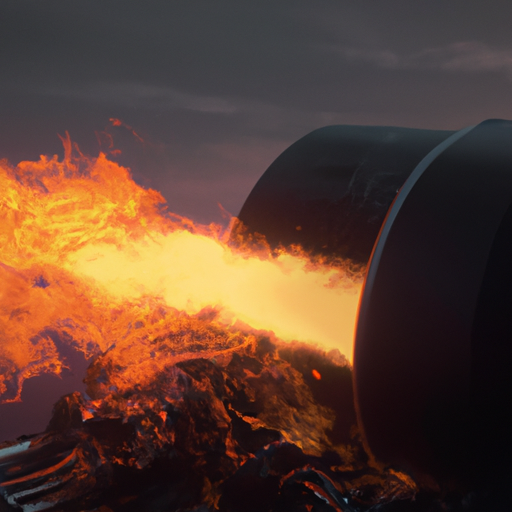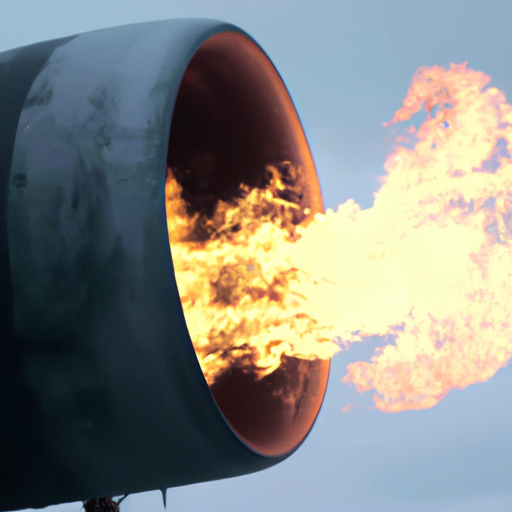
Advancements in First Fuel Burn Technology for Rolls-Royce’s New Hybrid-Electric Engine
Rolls-Royce, the renowned British engineering company, has achieved a significant milestone in the development of its new hybrid-electric engine. The company recently announced the successful completion of the first fuel burn on this groundbreaking engine, marking a major advancement in the field of aviation technology.
This achievement is a result of years of research and development by Rolls-Royce’s team of engineers and scientists. The new engine is designed to power hybrid-electric aircraft, which are seen as a promising solution to reduce carbon emissions and make air travel more sustainable. With this successful fuel burn, Rolls-Royce has taken a significant step towards realizing this vision.
The first fuel burn is a critical moment in the development of any new engine. It involves igniting the fuel and air mixture inside the engine’s combustion chamber, which generates the necessary power to propel the aircraft. This process requires precise control and coordination of various components, including fuel injectors, spark plugs, and sensors. Rolls-Royce’s engineers have worked tirelessly to ensure that everything functions seamlessly during this crucial phase.
The successful completion of the first fuel burn demonstrates the engine’s reliability and performance. It is a testament to the expertise and dedication of Rolls-Royce’s engineers, who have pushed the boundaries of technology to create an engine that is not only powerful but also environmentally friendly. This achievement brings us one step closer to a future where air travel is more sustainable and less harmful to the planet.
Rolls-Royce’s new hybrid-electric engine incorporates several innovative features that set it apart from traditional aircraft engines. One of the key advancements is the integration of electric motors, which work in conjunction with the combustion engine to provide additional power and efficiency. This hybrid configuration allows for reduced fuel consumption and lower emissions, making it a game-changer in the aviation industry.
Furthermore, the engine is designed to be compatible with various types of sustainable fuels, including biofuels and hydrogen. This flexibility ensures that the engine can adapt to future advancements in fuel technology, making it a future-proof solution for the aviation industry. Rolls-Royce’s commitment to sustainability is evident in every aspect of the engine’s design, from its fuel efficiency to its compatibility with alternative fuels.
The successful first fuel burn also paves the way for further testing and development of the engine. Rolls-Royce will now proceed with a comprehensive series of ground and flight tests to validate the engine’s performance under different operating conditions. These tests will provide valuable data and insights that will inform future improvements and refinements to the engine’s design.
In conclusion, Rolls-Royce’s achievement of the first fuel burn on its new hybrid-electric engine is a significant milestone in the advancement of aviation technology. This groundbreaking engine represents a major step towards more sustainable air travel, with its innovative features and compatibility with alternative fuels. The successful completion of the first fuel burn is a testament to Rolls-Royce’s expertise and dedication to pushing the boundaries of engineering. As the company continues its testing and development, we can look forward to a future where hybrid-electric aircraft become the norm, reducing carbon emissions and making air travel more environmentally friendly.
The Importance of First Fuel Burn in Achieving Efficient Hybrid-Electric Flight

Rolls-Royce, the renowned British engineering company, recently achieved a significant milestone in the development of their new engine for hybrid-electric flight. The first fuel burn of this groundbreaking engine marks a crucial step towards achieving efficient hybrid-electric flight. In this article, we will explore the importance of this milestone and how it paves the way for a greener and more sustainable future in aviation.
The first fuel burn is a momentous occasion in the development of any new engine. It signifies the successful ignition and combustion of fuel, which is essential for generating the power required to propel an aircraft. In the case of Rolls-Royce’s new engine, this milestone is particularly significant as it is specifically designed for hybrid-electric flight.
Hybrid-electric flight is an emerging technology that aims to reduce the environmental impact of aviation by combining traditional jet engines with electric propulsion systems. By integrating electric motors into the aircraft’s powertrain, it becomes possible to reduce fuel consumption and emissions significantly. However, achieving efficient hybrid-electric flight requires the development of advanced engines capable of seamlessly transitioning between conventional and electric power sources.
Rolls-Royce’s new engine is a testament to their commitment to innovation and sustainability. It is designed to be highly adaptable, allowing it to operate efficiently in both conventional and electric modes. This versatility is crucial for hybrid-electric flight, as it enables the engine to optimize its performance based on the specific requirements of each phase of flight.
The successful first fuel burn of Rolls-Royce’s new engine is a significant achievement for several reasons. Firstly, it demonstrates the engine’s ability to ignite and burn fuel effectively, which is essential for generating the necessary power. Secondly, it validates the engine’s design and engineering, proving that it can withstand the extreme conditions of combustion without any issues. Lastly, it showcases Rolls-Royce’s expertise in developing cutting-edge propulsion systems that are at the forefront of technological advancements in aviation.
Efficient hybrid-electric flight has the potential to revolutionize the aviation industry by significantly reducing its environmental impact. By combining traditional jet engines with electric propulsion systems, aircraft can achieve substantial fuel savings and emissions reductions. This is particularly important in an era where climate change and sustainability are at the forefront of global concerns.
The first fuel burn of Rolls-Royce’s new engine brings us one step closer to realizing the vision of efficient hybrid-electric flight. It serves as a reminder of the progress we have made in developing greener and more sustainable technologies for aviation. However, there is still much work to be done before hybrid-electric flight becomes a mainstream reality.
In conclusion, the first fuel burn of Rolls-Royce’s new engine for hybrid-electric flight is a significant milestone in the pursuit of efficient and sustainable aviation. It showcases the company’s commitment to innovation and their ability to develop cutting-edge propulsion systems. As we continue to strive for a greener future, the successful development of engines like this will play a crucial role in reducing the environmental impact of aviation. With each milestone achieved, we move closer to a world where flying is not only efficient but also environmentally friendly.
Exploring the Benefits and Challenges of First Fuel Burn on Rolls-Royce’s New Engine for Hybrid-Electric Flight
Rolls-Royce, the renowned British engineering company, recently achieved a significant milestone in the development of its new engine for hybrid-electric flight. The company successfully conducted the first fuel burn on this groundbreaking engine, marking a major step forward in the aviation industry’s quest for more sustainable and environmentally friendly air travel.
The benefits of hybrid-electric flight are numerous and compelling. By combining traditional jet engines with electric motors, aircraft can significantly reduce their carbon emissions and noise levels. This technology has the potential to revolutionize the way we fly, making air travel more sustainable and less harmful to the environment.
One of the key advantages of Rolls-Royce’s new engine is its ability to operate on both conventional aviation fuel and sustainable aviation fuel (SAF). This flexibility is crucial in the transition towards greener aviation, as SAF is a renewable alternative to fossil fuels. By using SAF, aircraft can reduce their carbon footprint by up to 80%, making a significant contribution to global efforts to combat climate change.
However, the development of hybrid-electric flight is not without its challenges. One of the main obstacles is the limited energy density of current battery technology. While batteries have made significant advancements in recent years, they still cannot match the energy density of aviation fuel. This means that electric motors alone cannot provide the necessary power for sustained flight. Rolls-Royce’s new engine addresses this challenge by combining the efficiency of traditional jet engines with the environmental benefits of electric propulsion.
Another challenge is the integration of hybrid-electric systems into existing aircraft designs. Retrofitting existing planes with hybrid-electric technology is a complex and costly process. However, Rolls-Royce’s new engine is designed to be easily integrated into existing aircraft, minimizing the need for extensive modifications. This makes it a more practical and cost-effective solution for airlines looking to transition to greener aviation.
Rolls-Royce’s achievement in conducting the first fuel burn on its new engine is a significant milestone in the development of hybrid-electric flight. It demonstrates the company’s commitment to innovation and sustainability in the aviation industry. By successfully combining traditional jet engines with electric motors, Rolls-Royce is paving the way for a greener and more efficient future of air travel.
The next steps for Rolls-Royce involve rigorous testing and optimization of the engine’s performance. This will ensure that it meets the stringent safety and reliability standards required for commercial aviation. The company is also working closely with industry partners and regulatory authorities to ensure that the necessary infrastructure and regulations are in place to support the widespread adoption of hybrid-electric flight.
In conclusion, Rolls-Royce’s first fuel burn on its new engine for hybrid-electric flight is a significant achievement that brings us one step closer to a more sustainable future of air travel. The benefits of hybrid-electric flight, such as reduced carbon emissions and noise levels, are clear. However, challenges remain, including the limited energy density of current battery technology and the integration of hybrid-electric systems into existing aircraft designs. Nevertheless, with continued innovation and collaboration, the aviation industry is on track to achieve its goal of greener and more environmentally friendly air travel.


